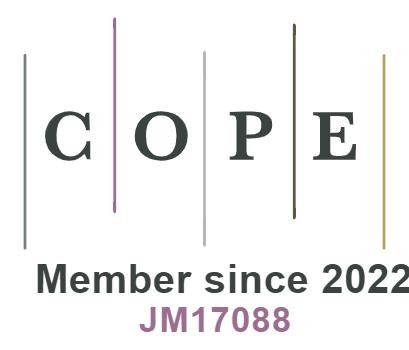Fixed-time integral sliding mode tracking control of a wheeled mobile robot
Abstract
This paper presents a fixed-time integral sliding mode control scheme for a nonholonomic wheeled mobile robot (WMR). To achieve the trajectory tracking mission, the dynamic model of a WMR is first transformed into a second-order attitude subsystem and a third-order position subsystem. Two novel continuous fixed-time disturbance observers are proposed to estimate the external disturbances of the two subsystems, respectively. Then, trajectory tracking controllers are designed for two subsystems by utilizing the reconstructed information obtained from the disturbance observers. Additionally, an auxiliary variable that incorporates the Gaussian error function is introduced to address the chattering problem of the control system. Finally, the proposed control scheme is validated by a wheeled mobile robotic experimental platform.
Keywords
1. INTRODUCTION
During the past decades, the wheeled mobile robot (WMR) has attracted extensive attention as it is widely used in various fields. The research on the WMR mainly includes robot positioning, motion planning, and motion control, among which the motion control is a fundamental problem. There are three main parts of the motion control, including point stabilization, path planning, and trajectory tracking [1]. The trajectory tracking control is a significant field in motion control, which has been studied extensively in recent years [2]. In practical engineering applications, a WMR is a highly coupled system with nonholonomic constraints and external disturbances. Hence, it is significant to design an anti-interference trajectory tracking control scheme with superior performance. At present, the design of the tracking controller of a WMR is mainly based on two types: one is to consider only the kinematic model [3], while the other is to design on the basis of kinematic and dynamic models [4]. The kinematic model-based control only considers the linear velocity and angular velocity as the control inputs. Compared with the kinematic model, the introduction of dynamic models can solve the external disturbance problem and the crucial nonholonomic constraint problem [5].
In [6], the system with nonhonolomic constraints was transformed into an extended chain system by coordinate transformation. On this basis, some scholars have designed the trajectory tracking control schemes by transforming the kinematic model of a WMR into a chain structure [7]. In practice, there is a problem called "excellent velocity tracking" [8] when designing a trajectory tracking controller only based on a kinematic system. Thus, it is more reasonable to take the force or torque as inputs of the control system instead of the speed. Meanwhile, external disturbances can be further taken into account. Nevertheless, the design process of the controller that simultaneously incorporates both the kinematic and dynamic models is complicated. The work of Zhai and Song [9] transformed the dynamic error system into second-order and third-order subsystems. And an intermediate variable related to the position error is introduced to tackle the problem of constructing a control method for a third-order system using the terminal sliding mode control. However, the aforementioned control schemes can only achieve finite time stability. It is noteworthy that the upper limit of the convergence time is unknown and dependent on the initial states of the control system. To overcome this problem, fixed-time stable control methods are proposed [10]. In reference [11], a new integral sliding mode-based control (ISMC) scheme was developed and applied on the dynamic model of the WMR to enable the WMR to track the desired trajectory in a fixed time. However, there exists the singularity problem, making the WMR unable to track the arbitrary trajectories and limiting its practical application when the desired angular velocity is zero.
In the practical motion environment, there are external disturbances and uncertainties that can deteriorate the performance of the control system. To cope with the problem, an observer-based control scheme is an efficient method with disturbance-rejection performance [12]. The traditional observers can only achieve asymptotic stability of the observation errors, whereas the finite time disturbance observers were designed to improve the performance of the observer [13]. On this basis, the fault-tolerant attitude control problem of spacecraft under external disturbances was solved by the introduction of a continuous finite-time observer [14], which also restrains the chattering phenomenon. Zhang et al. put forward a novel continuous practical fixed-time disturbance observer and applied it on a WMR, which can not only avoid the chattering problem but also improve the ability to attenuate disturbance [15]. Different from the work of Zhang, the Gaussian error function, which is sometimes called probability integral [16], can also be used to develop a control scheme that improves the chattering problem [17].
Motivated by the above discussions, an integral sliding mode-based fixed-time trajectory tracking control scheme is proposed by combining the kinematic model with the dynamic model of a WMR in this paper. (1) A continuous fixed-time disturbance observer using the Gaussian error function is proposed, which avoids the chattering problem and estimates the external disturbance of a WMR accurately. (2) An auxiliary variable incorporating variable exponential coefficients is introduced to simplify the design process of the controller for the third-order subsystem and avoid the singularity problem simultaneously. (3) The reliability and effectiveness of the designed control scheme are verified by a comparative experiment conducted on a wheeled mobile experimental platform.
2. PRELIMINARIES AND PROBLEM STATEMENT
2.1. Preliminaries
Lemma 1[18] Consider the following system as
If there exists a positive definite Lyapunov function
Lemma 2[16] The Gaussian error function is defined as follows:
where
Lemma 3[19] For
Lemma 4[20] The following inequality will hold
2.2. Dynamic model of WMR
A nonholonomic WMR system is shown in Figure 1. It consists of two balance wheels and two driving wheels, and the line between the balance wheels is perpendicular to the line between the driving wheels. The distance between the driving wheel and the barycentric coordinate is
with
The reference trajectory is defined as
where
Assumption 1: Suppose
Assumption 2: Suppose the
Then, the tracking errors of the WMR are expressed as
Furthermore, the error dynamics system could be transformed in the form of
To simplify the whole design process, the system (6) can be divided into two subsystems, which contain a second-order subsystem:
and a third-order subsystem:
3. FIXED-TIME TRAJECTORY CONTROL
In this section, a fixed-time sliding mode control scheme is developed to realize the fast and high-accuracy trajectory tracking control of a WMR under external disturbances. Firstly, a fixed-time disturbance observer and a new fixed-time sliding mode surface are proposed for the second-order subsystem (7). On this basis, a fixed-time controller is constructed to make the error variables,
3.1. Tracking control laws design for the second-order subsystem
Fixed-time disturbance observer
Firstly, for the attitude error subsystem (7), define an auxiliary variable as
where
The parameters
Theorem 1For the second-order subsystem (7), if the disturbance observer is constructed as
then it can estimate
Proof of Theorem 1 Select a Lyapunov function as
where
Case 1 When
As
Case 2 In the converse case
As
with
In view of the above two cases, the auxiliary variable
Then, the disturbance observation error
The disturbance
3.1.2. Fixed-time sliding mode controller
For the subsystem (7), define
with
where
Theorem 2For the second-order system (7), if the fixed-time controller is constructed in the form of (18), then the real sliding mode variable will converge into a small set within a fixed time.
Proof of Theorem 2 Choose a Lyapunov function as
where
3.2. Tracking control laws design for the third-order subsystem
After the angular error
3.2.1. Fixed-time disturbance observer
Introduce the following auxiliary variable for the simplified third-order subsystem (20)
where
where
Theorem 3For the simplified third-order subsystem (20), a fixed-time disturbance observer is developed in the form of
then it can estimate
Proof of Theorem 3 Similar to the proof of Theorem 1.
3.2.2. Fixed-time sliding mode controller
For the third-order subsystem (20), introduce the following auxiliary variable:
where
Select a fixed-time sliding mode surface as:
where
Theorem 4For the third-order subsystem (20), if the fixed-time sliding mode surface is chosen as (25) and the fixed-time controller is designed as (26),
then the sliding mode surface
Proof of Theorem 4 The proof process will be conducted in 3 steps: (1) After the angular error
Step 1 Select a positive Lyapunov function
where
Then,
Step 2 According to (25), when the auxiliary
Choose a Lyapunov function as
where
Then, it can be obtained that the
Step 3 Before the angular error
Consider the following bounded function:
The time derivative of
Let
where
On the contrary, if
Remark 1 The auxiliary variable
4. EXPERIMENT RESULTS
To verify the effectiveness of the proposed control scheme, the trajectory tracking experiment is implemented on a Quanser QBot 2e mobile robot platform composed of a QBot 2e mobile robot, an OptiTrack system with 12 infrared cameras, and a computer. The experimental platform is presented in Figure 2. The whole closed-loop experiment structure is as follows: The simulation diagram is compiled on the host computer equipped with MATLAB/Simulink to transform the simulation into an executable file. And the control scheme is written to the Gumstix computer embedded in the QBot 2e through wireless communication protocol. The real-time position information of the QBot 2e is obtained by the OptiTrack positioning system. Then the host computer calculates the information and transmits them to the embedded computer of a WMR for the input of real-time calculation of executable files. So as to complete the trajectory experiment of the mobile robot.
In the experiment, the physical parameters of the QBot 2e are chosen as follows:
It is obvious that the WMR trajectory tracking mission can be achieved by the designed control method as plotted in the red track in Figure 3. The time response curves of the sliding mode surfaces,
Figure 3. The comparative trajectory tracking experiment results of the WMR. WMR: wheeled mobile robot.
Figure 6. Comparative results of tracking errors
5. DISCUSSION
In this paper, a universal control scheme for fixed-time trajectory tracking based on ISMC is put forward. The dynamic model of the WMR has been transformed into two error subsystems. Then utilizing the fixed-time technology and ISMC, a new fixed-time disturbance observer has been proposed and applied on the two error subsystems. Furthermore, an observer-based tracking control method has been proposed to achieve a trajectory tracking mission for the WMR, and guarantee the tracking error converges within a fixed time. Finally, the proposed control approach has been verified by a mobile robotic platform, and the experimental results show fine control performances. Our future work will focus on how to realize the formation tracking control of multi-wheeled mobile robots in both theory and experiment.
DECLARATIONS
Acknowledgments
The authors would like to thank the editors and reviewers for their valuable comments dedicated to this article.
Authors' contributions
Made significant contributions in writing, methodology, review: Li B
Executed writing-original draft, experiment verification: Ma L
Methodology validation: Wang C
Data result analysis: Ge C
Supervision and modification: Liu H
Availability of data and materials
Not applicable.
Financial support and sponsorship
This work was supported in part by the National Natural Science Foundation of China (62073212), Natural Science Foundation of Shanghai (23ZR1426600), and Innovation Fund of Chinese Universities Industry-University-Research (2021ZYB05004).
Conflicts of interest
All authors declared that there are no conflicts of interest.
Ethical approval and consent to participate
Not applicable.
Consent for publication
Not applicable.
Copyright
© The Author(s) 2023.
REFERENCES
1. Panahandeh P, Alipour K, Tarvirdizadeh B, Hadi A. A kinematic Lyapunov-based controller to posture stabilization of wheeled mobile robots. Mech Syst Signal Pr 2019;134:1-19.
2. Huang H, Li Y, Bai Q. An improved a star algorithm for wheeled robots path planning with jump points search and pruning method. Complex Eng Syst 2022;2:11.
3. Kanayama Y, Kimura Y, Miyazaki F, Noguchi T. A stable tracking control method for an autonomous mobile robot. In: Proceedings., IEEE International Conference on Robotics and Automation; 1990;1. pp. 384-89.
4. Fierro R, Lewis F. Control of a nonholonomic mobile robot: backstepping kinematics into dynamics. In: Proceedings of 1995 34th IEEE Conference on Decision and Control; 1995;4. pp. 3805-10.
5. Bloch A. Nonholonomic mechanics and control. Interdisciplinary Applied Mathematics New York, NY: Springer; 2003.
6. Murray R, Sastry S. Nonholonomic motion planning: steering using sinusoids. IEEE Trans Automat Contr 1993;38:700-16.
7. Tayebi A, Tadjine M, Rachid A. Invariant manifold approach for the stabilization of nonholonomic chained systems: Application to a mobile robot. Nonlinear Dynam 2001;24:167-81.
8. Wang X, Zhang G, Neri F, et al. Design and implementation of membrane controllers for trajectory tracking of nonholonomic wheeled mobile robots. Integr Comput-Aid E 2016;23:15-30.
9. Zhai J, Song Z. Adaptive sliding mode trajectory tracking control for wheeled mobile robots. Int J Control 2019;92:2255-62.
10. Ou M, Sun H, Zhang Z, Li L. Fixed-time trajectory tracking control for multiple nonholonomic mobile robots. T I Meas Control 2021;43:1596-608.
11. Li B, Zhang H, Xiao B, Wang C, Yang Y. Fixed-time integral sliding mode control of a high-order nonlinear system. Nonlinear Dynam 2022;107:909-20.
12. Liu Q, Cai Z, Chen J, Jiang B. Observer-based integral sliding mode control of nonlinear systems with application to single-link flexible joint robotics. Complex Eng Syst 2021;1:8.
13. Zhang Z, Leibold M, Wollherr D. Integral sliding-mode observer-based disturbance estimation for euler–lagrangian systems. IEEE Trans Contr Syst T 2020;28:2377-89.
14. Li B, Hu Q, Yang Y. Continuous finite-time extended state observer based fault tolerant control for attitude stabilization. Aerosp Sci Technol 2019;84:204-13.
15. Zhang H, Li B, Xiao B, Yang Y, Ling J. Nonsingular recursive-structure sliding mode control for high-order nonlinear systems and an application in a wheeled mobile robot. ISA T 2022;130:553-64.
16. Chevillard S. The functions erf and erfc computed with arbitrary precision and explicit error bounds. Inform Comput 2012;216:72-95.
17. Eltayeb A, Rahmat M, Basri MAM, Mahmoud MS. An improved design of integral sliding mode controller for chattering attenuation and trajectory tracking of the quadrotor UAV. Arab J Sci Eng 2020;45:6949-61.
18. Ba D, Li Y, Tong S. Fixed-time adaptive neural tracking control for a class of uncertain nonstrict nonlinear systems. Neurocomputing 2019;363:273-80.
19. Bagul Y, Chesneau C. Sigmoid functions for the smooth approximation to the absolute value function. MJPAA 2021;7:12-19.
21. Jiang Z, Nijmeijer H. Tracking control of mobile robots: A case study in backstepping. Automatica 1997;33:1393-99.
22. Wang C, Wen G, Peng Z, Zhang X. Integral sliding-mode fixed-time consensus tracking for second-order non-linear and time delay multi-agent systems. J Franklin I 2019;356:3692-710.
23. Plestan F, Shtessel Y, Brégeault V, Poznyak A. New methodologies for adaptive sliding mode control. Int J Control 2010;83:1907-19.
24. Song T, Fang L, Wang H. Model‐free finite‐time terminal sliding mode control with a novel adaptive sliding mode observer of uncertain robot systems. Asian J of Control 2022;24:1437-51.
25. Li B, Gong W, Yang Y, Xiao B, Ran D. Appointed fixed time observer-based sliding mode control for a quadrotor UAV under external disturbances. IEEE Trans Aero Elec Sys 2022;58:290-303.
Cite This Article
How to Cite
Download Citation
Export Citation File:
Type of Import
Tips on Downloading Citation
Citation Manager File Format
Type of Import
Direct Import: When the Direct Import option is selected (the default state), a dialogue box will give you the option to Save or Open the downloaded citation data. Choosing Open will either launch your citation manager or give you a choice of applications with which to use the metadata. The Save option saves the file locally for later use.
Indirect Import: When the Indirect Import option is selected, the metadata is displayed and may be copied and pasted as needed.
About This Article
Copyright
Data & Comments
Data
























Comments
Comments must be written in English. Spam, offensive content, impersonation, and private information will not be permitted. If any comment is reported and identified as inappropriate content by OAE staff, the comment will be removed without notice. If you have any queries or need any help, please contact us at [email protected].